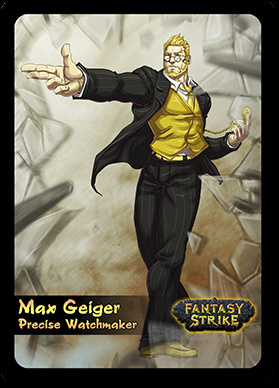
Geiger is a man who knows that there is time enough for anything. He controls the tempo of the game as he sees fit, and - if given enough time by his opponent - can end the round in a single combat, totally demolishing an opponent no matter their health. If a lategame-focused attack-heavy character with a variety of relevant attack speeds and incredible card selection is what you’re looking for, your time of searching has come to an end - Geiger is here.
Pros and Cons
Pros:
-
Several relevant attack speeds, with appropriate rewards for exploiting each
-
Very strong lategame thanks to Temporal Distortion
-
With early access to face cards, also an incredibly strong (and safe) earlygame thanks to Time Stop
-
Above-average health affords him the opportunity to take damage
-
Ready access to knockdown off of multiple combat options
Cons: -
Slow throws (x.8 speed)
-
Card-hungry if frequently using Time Stop or if he wants to threaten with Temporal Distortion combos
-
Without access to face cards early, has a much weaker earlygame
-
Very reliant on face cards in general to execute his gameplan
-
As a third of his dodges are on his most important ability (Temporal Distortion), has fewer-than-average dodges compared to the rest of the cast
Spiraling Out Of Control
Geiger is centered around his Time Spirals, which are located on his Jack (Fast Time Spiral), his Queen (Slow Time Spiral), and the 2.0-speed side of his AA attack (Time Spiral Hurricane). His innate and both of his activated abilities either use Time Spirals directly, or capitalize on the Time Spirals he’s already used.
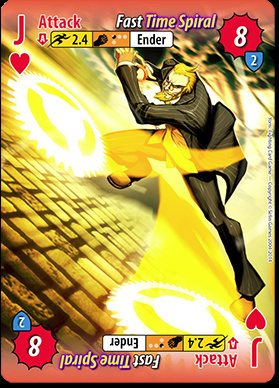
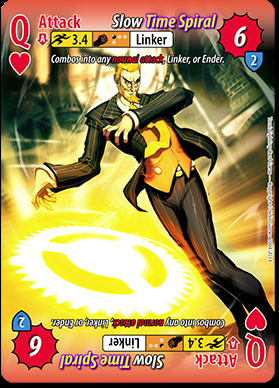

As his fastest Time Spiral is speed 2.0, they are relatively slow compared to other attacks. However, his innate gives them a unique property that makes them incredible coverage moves.
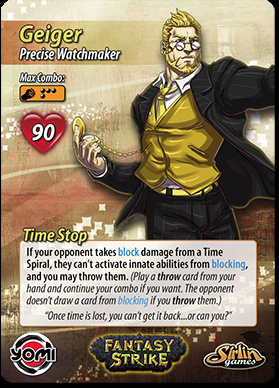
Yep, Geiger can win by attacking into a block if he’s willing to expend a throw! This means that Time Spirals beat both throws (because attacks beat throws anyway) and blocks (because of Time Stop), making them phenomenal combat reveals. Note that if Time Stop triggers, even if you don’t follow up with a throw, 
 and
and  cannot trigger their innate abilities by blocking. As Time Stop requires a throw, however, you will need to block a fair amount in order to use Time Stop consistently - using 2 cards to win combat against one opposing block is fine, but this will gradually give your opponent more cards in hand compared to you. You also need to block to gain access to more Time Spirals, but opposing fast attacks and dodges (which beat your Time Spirals) play directly into helping Geiger block to build.
cannot trigger their innate abilities by blocking. As Time Stop requires a throw, however, you will need to block a fair amount in order to use Time Stop consistently - using 2 cards to win combat against one opposing block is fine, but this will gradually give your opponent more cards in hand compared to you. You also need to block to gain access to more Time Spirals, but opposing fast attacks and dodges (which beat your Time Spirals) play directly into helping Geiger block to build.
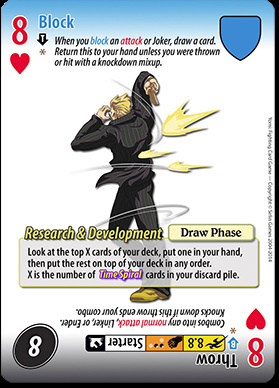
One of the more difficult abilities in the game to use correctly, so much so that it will get its own section. Suffice to say that this gives you a reason to use Time Spirals relatively freely, as more Time Spirals in the discard gives you more card selection. Notably, using AA as the 0.0 speed Cycloid Revolution - and using additional aces as pumps - will also count as putting Time Spirals in the discard.

The threat of Temporal Distortion is enough to give Geiger one of the most terrifying endgames in Yomi. Even if Geiger is down to a sliver of health and his opponent has a full lifebar, one Temporal Distortion combat win can result in a Geiger victory. The combination of making his Time Spirals 0 combo point linkers and also making them unjokerable gives Geiger incredible combo potential, with the extra 1 point of damage per Time Spiral sometimes pushing combats into lethal range that weren’t before. Geiger’s Time Spirals also become unjokerable dodge followups, which is primarily useful to threaten Time Spiral Hurricane.
This gives Geiger a simple three-step plan to win a matchup, assuming things line up properly:
-
Use Time Spirals in the early game to simultaneously pressure the opponent’s blocks with Time Stop and to ward off opposing throws, allowing Geiger an opportunity to block and build up a hand.
-
Use Research & Development to fix your draws, allowing Geiger to draw into the rest of a Temporal Distortion combo OR to draw into Jokers and fast attacks (Aces and Kings).
-
Activate Temporal Distortion and obliterate your opponent’s lifebar in one hit.
This might seem like an incredibly reductive and basic strategy, but it’s strong and solid enough to hold up at the very highest levels of play! If you’re just starting off with Geiger, using this three-step plan will teach you enough about Geiger to win. However, you’ll quickly find that there’s a missing piece to the puzzle! After all, fast attacks are generally enough to stifle the third step of this plan, as well as being pretty solid against Time Spirals in general. So what enables Geiger to hit the opponent for 80+ damage Temporal Distortion combos?
Rykerball - Turning Aces Into Wins
Named after v1’s most influential Geiger player, Rykerball refers to using Geiger’s incredibly strong Aces to enforce the rest of his gameplan.

According to Rykerball, the most important part of his Ace isn’t a Time Spiral at all! At 0.0 speed, Cycloid Revolution is tied with Dragonheart, Ninpo Flash, Shadow Slice, Maximum Anarchy, and Rising Dragon as the fastest attack in the game (barring Final Authority). Notably, Cycloid Revolution wins the trade against all of these attacks except the 4-ace Maximum Anarchy! A fully pumped Cycloid Revolution also does 40 damage, which is anywhere from 40-57% of a character’s lifebar. The threat of very efficient and high damage off of Cycloid Revolution activates the rest of Geiger’s character:
-
Blocking not only gives Geiger fuel for Time Stop; it also gives Geiger triplets and pairs that he can turn into Aces.
-
Cycloid Revolution beats any fast attacks that would ward off an aggressive Geiger range focused on Time Stops.
-
The opponent’s only real answer to Cycloid Revolution is to Gold Burst, dodge, or block. This opens up Geiger to be more aggressive, and alternatively it can open Geiger up to block (which ties or beats all of these options).
Geiger, of course, has another fast attack that can function for backing up Cycloid Revolution, located on his King.
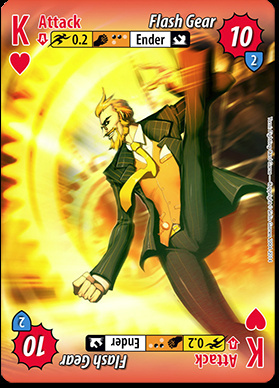
At 0.2 speed, Flash Gear will still beat (or trade favorably with) most attacks in the game. At 10 damage for a single card, it’s incredibly damage-efficient. Flash Gear is also a 2 CP ender that can be tacked on to any combo starter Geiger has, including Time Stop. Flash Gear also knocks down on hit, which is the focus of our next section.
Fade Em, Knock Em Down
So far, we’ve looked primarily into Geiger’s attacks thanks to either their ability to beat blocks and throws simultaneously, or their damage and speed. As so much of his gameplan that we’ve explored so far relies on his attacks, Geiger benefits from knockdown more than perhaps any other character in the game:
-
A knocked down opponent cannot dodge. This enforces an incredibly strong mixup just using Geiger’s AAs: Time Spiral Hurricane (which beats blocks for 11 damage and another KD or sometimes 21 damage and another KD, while beating throws for 20) and Cycloid Revolution (which beats or trades generally favorably with attacks used to outspeed Time Spiral Hurricane, while also beating throws for 20-40 damage). Even without using Aces, Geiger’s J and Q suddenly only really lose to attacks faster than 2.4 or 3.4 respectively.
-
Mixup normals inordinately favor Geiger - he draws a card against any non-Defense Mastery character (accelerating him into face cards or Temporal Distortion) on hit or block, and on hit he can add a K to the end of his combo to knock down the opponent again, or he can potentially combo a 567 straight to find an Ace. This also gives Geiger an opportunity to beat blocks and throws without expending a Time Spiral (and with a higher potential damage payout), at the cost of being slightly to significantly slower.
As the opponent will likely want to hit Geiger out of Time Spirals and mixup normals with faster attacks (or Gold Bursts), a knockdown also allows Geiger an opportunity to block. Setting up a knockdown to force a fast attack out of an opponent’s hand is an incredibly strong swing for Geiger:
-
That fast attack cannot be used to contest a Temporal Distortion in the late game (or must be powered up for if it’s an Ace, further stressing the opponent’s hand).
-
If the opponent has limited fast attacks, Geiger’s “standing” (no knockdown) Time Spirals become briefly stronger, as the fast attack the opponent expended cannot contest J and Q.
-
Blocking an attack benefits Geiger immensely, as he needs a large hand to enforce Time Stop and threaten with Temporal Distortion.
These advantages are amplified in Temporal Distortion, as an opponent who cannot dodge is given one less way to avoid taking significant damage from a Temporal Distortion combo.
With the sheer benefit Geiger gets from knocking the opponent down, he’s also fortunate to have a variety of ways to do this:
-
If the opponent is frequently dodging or blocking, Geiger can “just” throw the opponent.
-
If the opponent is attempting to rush Geiger down with attacks and throws, Geiger can play Flash Gear.
-
If the opponent is blocking more than dodging - but also might throw Geiger! - Geiger can attempt a Time Stop knockdown. The knockdown here is only guaranteed if Geiger uses Slow Time Spiral, as Fast Time Spiral on hit will “just” do 8 damage. Slow Time Spiral, since it’s a linker, can combo into Flash Gear.
-
If the opponent is throwing like a lunatic, Geiger can hit the opponent with 5 6 (or 6 7) into Flash Gear and make them regret their decisions.
-
If Geiger doesn’t have Flash Gear in his hand but is still forced to contend with fast attacks (or has a Flash Gear but needs to conserve it), he can use one of his relatively few dodges and dodge into a throw.
The damage Geiger can gain off of his knockdown offense also adds a lot of threat to Cycloid Revolution, as a 60 health opponent stands to lose their entire lifebar in 2 combats simply to Aces (fully pumped Cycloid Revolution, followed by an unpumped Cycloid Revolution for lethal), as well as making it less necessary to have an inordinately large hand to threaten large Temporal Distortion combos. Knockdown game and Rykerball make Geiger’s gameplan a lot more multi-faceted, and gives Geiger a way to play out of any hand. A mixture of strong aggression and knowing when you can find opportunities to block to set up highly destructive Temporal Distortion hands is the key to a successful Geiger.
To summarize:
- Geiger wants to primarily block to set up either Cycloid Revolution or Temporal Distortion, frequently threatening both simultaneously.
- Geiger needs to attack in order to protect his blocks from being thrown. Time Spirals are card-hungry due to Time Stop, but always beat normal blocks (and frequently set up knockdowns). Normal draw means that normal attacks will always replace themselves against non-Defense Mastery characters assuming they hit or are blocked, but can accelerate the opponent if they are blocked.
- Once the opponent is knocked down, Geiger can freely be aggressive, which makes his original plan (blocking for Aces and Temporal Distortion) even stronger. This makes knocking down the opponent Geiger’s secondary gameplan, and thankfully he has many ways to do this.
- Throws are still necessary to stop opponents from dodging, as well as beating opposing blocks without committing two cards. However, Geiger is generally going to be weighted towards attacking and blocking.
Card-By-Card Analysis
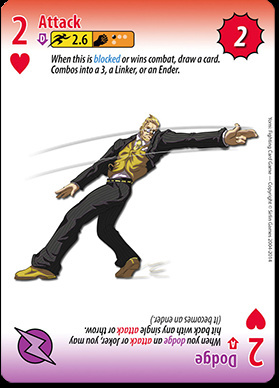
Geiger’s 2 is his fastest normal attack, as well as one of his relatively limited dodges. The attack side can be used to ward off knockdown offense against other characters with x.6 speed normals, or as a part of his own knockdown offense. As a dodge at all, Geiger’s 2 is also strong for evading fast attacks to set up knockdowns. Powering up with 2s can be acceptable in situations where access to Cycloid/Time Spiral Hurricane outweighs having access to dodges (or you have 3s in hand).
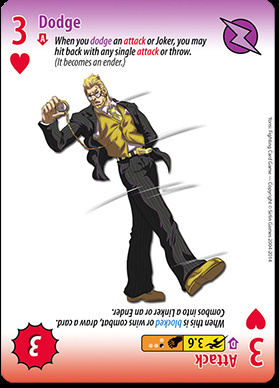
Geiger’s 3 is his best dodge. Geiger’s 3 generally doesn’t beat relevant attacks that also beat Geiger’s 5; since Geiger’s 5 can be used as the start of his only straight, this reduces Geiger’s 3’s utility as an odd mixup normal. Powering up with 3s follows the same rules that powering up with his 2s do.

As Temporal Distortion is such a powerful ability, Geiger’s 4 is rarely used as a combat-reveal, with the incredibly rare exception of a situation where dodges are necessary to close a game out or Geiger has no other throws in his hand. The 1 extra damage from Suplex of Science generally doesn’t outweigh the cost of losing a Temporal Distortion unless the throw would end the game. Powering up with 4s is almost always a desperation move.
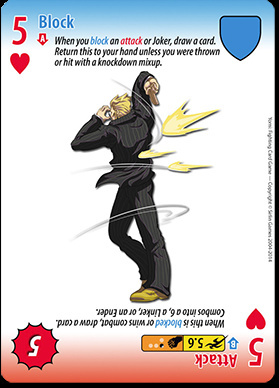
Geiger’s best odd mixup normal (as it opens up his 5-6-7 straight and isn’t tied to a dodge), and also Geiger’s best odd block. Powering up with 5s is perfectly acceptable provided blocks are present in your hand afterward.
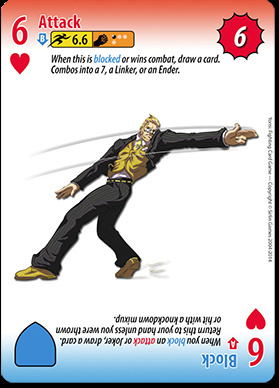
A relatively beefy even mixup normal and Geiger’s best even block. Can also be used as an efficient combo filler (and obviously necessary as such for Geiger’s straight). Follows the same powerup rules as Geiger’s 5.
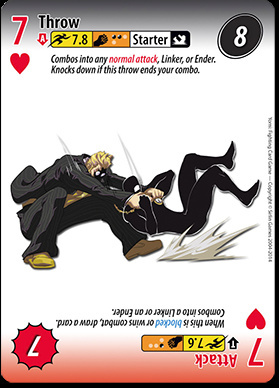
Geiger’s fastest throw, and also Geiger’s weakest odd mixup normal as a result; the fast throw on his 7 is more generally relevant than the dodge on Geiger’s 3, and both are outclassed by his 5 as mixup normals. Powering up with 7s is usually a mistake or a desperation move.

Research & Development is less generally useful than Temporal Distortion, but is still a powerful enough ability to make this Geiger’s worst even block. The 8.8 speed throw is all right to use, but as Geiger uses his throws as combat-reveals slightly less than other characters thanks to Time Stop, it’s generally worth saving the 8 as an ability. Powering 8s away is usually a very weak move, as the card selection from R&D will usually set up better powerups or draw Aces outright.
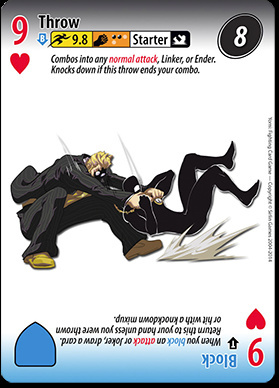
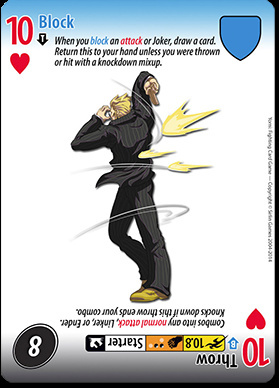
Geiger’s 9 and 10 are incredibly functionally similar; both are very slow throws, and both function as perfectly acceptable blocks (his only other even block besides his 5 and his second-best odd block, respectively). As his slowest throws, these are Geiger’s best throws to throw into a Time Stop. Powering with 9s and 10s is usually fine, but take care to not run too low on throws, as this defuses Time Stop completely and makes Temporal Distortion significantly weaker.


J and Q are both identical for the purposes of Time Stop and counting for Research and Development. Where they differ is in speed and payout:
At 2.4 speed, J functions very well as knockdown defense against x.4 speed mixup normals, while also preventing the opponent from using a knockdown to set up a block. 2.4 is generally one of the most relevant speeds in the game, contesting at least one important move from almost every character. However, as an ender, J will only ever deal 8 damage on hit outside of Temporal Distortion.
At 3.4 speed, Q is significantly weaker as knockdown defense and loses to many moves that J ties or beats outright. However, on hit, Q grants Geiger a pretty strong combo, with anything from 567 straight, to normal filler into K, or even into straight-up Time Spiral Hurricane.
J is a solid combo ender assuming knockdown is not terribly important. Q can fill combos relatively well, at 1 combo point for 6 damage.
Powering up with Js and Qs, while a pretty odd-looking decision, can actually benefit Geiger quite a bit. Having access to AA is generally a very powerful thing. In addition, having extra Time Spirals in the discard feeds Research & Development. Finally, Geiger can recur his Js and Qs one at a time with Temporal Distortion, which keeps them from being locked in the discard. This also makes Js and Qs perfectly acceptable face-down bluffs in the right situations!

This card was covered earlier, but the section on knockdowns should underscore just how strong Geiger’s K is. 0.2 speed is dominant - or trades favorably with an opposing dominant attack - in the vast majority of matchups. Combos well with the exception of the fact that, in general, throw -> K is not a fantastic combo unless the damage conversion is necessary that very combat, as K can be added onto a followup combo the next turn (or used to beat opposing fast attacks used to combat Time Stop or mixup normals). Powering up with Ks is almost certainly a mistake.

Both sides of Geiger’s Ace are essential to Geiger’s gameplan, making his Ace pretty versatile. As Cycloid Revolution, Geiger threatens fairly sizeable burst damage off of a 0.0 speed attack, making “hit with Cycloid a few times” a perfectly viable alternate gameplan to “hit with a grotesque Temporal Distortion combo.”
Time Spiral Hurricane is a fairly unique attack. In matchups where 2.2 is a specifically relevant speed and 2.4 is significantly weaker, Time Spiral Hurricane is incredibly strong, as its 2.0 speed is quite relevant for beating 2.2 speed attacks while its properties as a Time Spiral allow it to also beat blocks. This gives Geiger a fairly interesting range of speeds, with two sub-1,0 attacks that can be blocked profitably, and a whole host of other attacks at oddly relevant speeds that either defeat block or are normals. Time Spiral Hurricane is also a fairly solid combo ender outside of Temporal Distortion, as it follows up Q or any single normal for 20 damage.
Combos
These combos assume Temporal Distortion is not up. If Temporal Distortion is up, the combo is “play as many cards as you possibly can and make the opponent’s life bar disappear.” All throw combos have an extra 2-3 damage added on if they began from Time Stop.
Throw -> K: 18, KD
Throw -> 5/6/Q/7 -> J: 21-23
Q567: 24, gain an Ace
Q6K: 22, KD
Q -> AA: 26
567J: 26, normal draw, gain an Ace
normal -> K: 12-16, KD, normal draw
normal -> AA: 22-26, normal draw
23, 56 or 67 -> K: 15, 21, or 23, KD, normal draw
6Q6J (Geiger’s Spaghetti): 26, normal draw
Back to the Lab Again - Research & Development

Research and Development gives Geiger the opportunity to dig further into his deck to pull out a specific card, fix his draws for the next couple of turns, or signal to Geiger that he might want to power up to reshuffle his deck.
In general, Research & Development is not worth using unless you have three Time Spirals or more in the discard. Once Geiger has 5 or more, it generally gives incredible digging power. In general, these are the cards Geiger should look for:
Joker Tier: Joker
Geiger is the only character who can use an ability to guarantee he draws a Joker that turn, provided it’s within the top X (Spirals-in-discard) cards of his deck. Having a Gold Burst to find Aces for Rykerball, or a Rewind Time to make his gameplay generally safer, is extra important for Geiger. If you find a Joker, grab it unless you can guarantee a lethal checkmate combat that very turn.
Top Tier: King, Ace (with an Ace or powerup either in hand or next in line from R&D), Ace powerups
Geiger’s fast attacks enable the rest of his gameplan, especially in tandem with the knockdown from his K.
Spiral Tier: Jack, Queen, 4
Time Spirals are the focal point of Geiger, but are lower on the list than Jokers and fast-attacks because the other cards are generally more useful. However, having a Temporal Distortion up - or spirals to fuel an ongoing Temporal Distortion - is powerful enough to warrant considering over K and A on occasion.
Situational/High Tier: Pretty much everything else except 8
Usually the bottom of a pile: 8
The reason for this, even though 8s are generally good, is that you want to maximize the strength of your draws before you dig again. However, if your other cards truly don’t help you in any way after you’ve draw into a Joker/K/A/whatever, it’s strong to sandwich your 8 between your strong and weak cards in order to continue digging for other strong cards.
Another thing to consider is the fact that you get to order your cards. Assume you see 5 cards, and you see the following:
A 5 5 7 Joker
Your hand contents can change the valuation of the ordering after you get your Joker significantly! Assuming no aces in hand or discard, the following two orderings can be considered:
Joker, 7, Ace, 5, 5 OR Joker, Ace, 5, 5, 7
The first ordering gives access to a fast throw relatively quickly, while the second ordering is the fastest possible guaranteed AA (since powering the 5s would reshuffle the A and 7 back into the deck). Assuming an Ace in hand, the second ordering is generally better, since you’re guaranteed access to AA after you get your Joker!
More complex situations can arise, which might find their way into this guide in the future.
Does Time Bend, or Does It Break? - Temporal Distortion

As Geiger’s signature ability, Temporal Distortion is understandably a very large portion of his gameplan. How to handle the Temporal Distortion mixup may very well be the most important factor in succeeding with Geiger!
The first thing to notice is any non-Time Spiral combo filler - or Time Stop throw - can still be evaded by Rewind Time. Keep this in mind when calculating your maximum damage assuming the presence of a Joker.
Assuming a knocked down opponent - and a medium-to-large hand - the following mixup is simple, yet strong:
-
Just play a Time Spiral. Beats all throws, all normal blocks, and all attacks slower than the spiral that you reveal, and generally should win the game if Geiger connects with either the spiral or the followup Time Stop.
-
Play a fast attack (K or Cycloid Revolution). This beats throws and any fast attacks used to outspeed Time Spirals, for anywhere from 10 damage and a knockdown to 40 damage. This is generally the primary avenue to victory against characters who have plentiful fast attacks to avoid getting hit by Time Spirals, as they also tend to have low enough health (


 come to mind) where Cycloid Revolution can end the game just as easily as Temporal Distortion
come to mind) where Cycloid Revolution can end the game just as easily as Temporal Distortion -
Block (or dodge). This beats fast attacks as well as Gold Bursts, while giving either more cards with which to get Aces/damage, or a dodge followup (unjokerable 21, jokerable 30-40, or a knockdown). This becomes a much better option against
 with Maximum Anarchy or
with Maximum Anarchy or 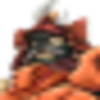 with Final Authority stocked, but is also good against other 0.0 characters who will take a trade with Cycloid in order to remove Temporal Distortion. It’s actually incredibly hard to stop Geiger from blocking, as attempting to throw Geiger’s blocks risks losing the game outright to a gigantic combo. It can also be worth blocking a reversal even with Cycloid in hand in order to make the opponent much softer to a Time Stop attempt the next turn.
with Final Authority stocked, but is also good against other 0.0 characters who will take a trade with Cycloid in order to remove Temporal Distortion. It’s actually incredibly hard to stop Geiger from blocking, as attempting to throw Geiger’s blocks risks losing the game outright to a gigantic combo. It can also be worth blocking a reversal even with Cycloid in hand in order to make the opponent much softer to a Time Stop attempt the next turn.
Using Time Spiral Hurricane as a Time Stop or Cycloid Revolution as a piece of the mixup does carry the risk of removing a sizeable amount of unjokerable damage from Geiger’s hand. Generally, J functions better as the Time Spiral of choice, but in matchups where 2.0 is a more relevant reveal speed than 2.4, Time Spiral Hurricane can win games that Fast Time Spiral would not.
Against standing opponents - or opponents who have blocks that avoid block damage - normal throw is also good to beat dodge and special block. This also increases Geiger’s damage if he throws a block as opposed to using Time Stop, as he’ll get the damage from the throw guaranteed as well as the full unjokerable damage from a Time Spiral.
Temporal Distortion can also be used earlier in the game to recur single Time Spirals. This is usually fine if early pressure is paying off, as Geiger can then continue pressuring with Time Stop. Keep in mind that the opponent is more likely to throw against what I’ll call a “tempo” Temporal Distortion, as the threat of a huge damage payout from a successful spiral hit is pretty safely not in Geiger’s hand.
Finally, Temporal Distortion combos do not have to kill the opponent. Dropping the opponent into sub-20 (Cycloid/TSH is lethal) or sub-10 (Flash Gear/Time Stop is lethal) life totals is also fine. Non-lethal Temporal Distortion combos carry the added benefit of gargantuan R&D followups, which can easily guarantee a strong endgame hand for Geiger to finish the opponent with.
Coming later: Matchups and Geiger Puzzles!


 come to mind) where Cycloid Revolution can end the game just as easily as Temporal Distortion
come to mind) where Cycloid Revolution can end the game just as easily as Temporal Distortion with Maximum Anarchy or
with Maximum Anarchy or  with Final Authority stocked, but is also good against other 0.0 characters who will take a trade with Cycloid in order to remove Temporal Distortion. It’s actually incredibly hard to stop Geiger from blocking, as attempting to throw Geiger’s blocks risks losing the game outright to a gigantic combo. It can also be worth blocking a reversal even with Cycloid in hand in order to make the opponent much softer to a Time Stop attempt the next turn.
with Final Authority stocked, but is also good against other 0.0 characters who will take a trade with Cycloid in order to remove Temporal Distortion. It’s actually incredibly hard to stop Geiger from blocking, as attempting to throw Geiger’s blocks risks losing the game outright to a gigantic combo. It can also be worth blocking a reversal even with Cycloid in hand in order to make the opponent much softer to a Time Stop attempt the next turn.